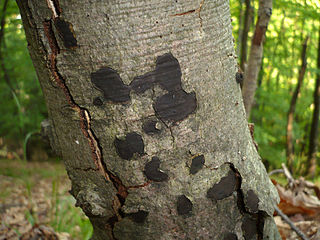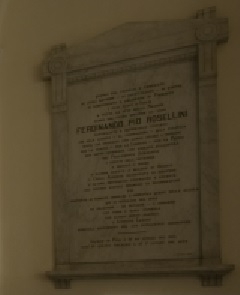
Mycology is the branch of biology concerned with the study of fungi, including their genetic and biochemical properties, their taxonomy and their use to humans, including as a source for tinder, traditional medicine, food, and entheogens, as well as their dangers, such as toxicity or infection.

Petter Adolf Karsten was a Finnish mycologist, the foremost expert on the fungi of Finland in his day, and known in consequence as the "father of Finnish mycology".

The Xylariaceae are a family of mostly small ascomycetous fungi. It is one of the most commonly encountered groups of ascomycetes and is found throughout the temperate and tropical regions of the world. They are typically found on wood, seeds, fruits, or plant leaves, some even associated with insect nests. Most decay wood and many are plant pathogens.

Julius Oscar Brefeld, usually just Oscar Brefeld, was a German botanist and mycologist.
Holmiella is a genus of fungi in the order Patellariales.

Biscogniauxia is a genus of fungi in the family Xylariaceae. Subtaxa include Biscogniauxia capnodes var. capnodes, Biscogniauxia marginata and Biscogniauxia nummularia, which are plant pathogens. The genus was circumscribed by Otto Kuntze in Revis. Gen. Pl. 2 on page 398 in 1891.
Engleromyces is a genus of fungi in the family Xylariaceae. The genus contains two species, the type Engleromyces goetzei and E. sinensis, described as new in 2010. The genus was circumscribed in Bot. Jahrb. Syst. Vol.28 on page 327 in 1900 by German mycologist Paul Christoph Hennings.
Guestia is a genus of sac fungi in the family Xylariaceae. This is a monotypic genus, containing the single species Guestia gonetropospora.
Pidoplitchkoviella is a genus of fungi in the family Xylariaceae. This is a monotypic genus, containing the single species Pidoplitchkoviella terricola.
Metrodia is a genus of fungi in the family Agaricaceae. It was circumscribed in 1971 by mycologist Jörg H. Raithelhuber, with M. collybioides as the type species. M. excissa was added to the genus in 1983.
Rebentischia is a genus in the Tubeufiaceae family of fungi.

The Mixiomycetes are a class of fungi in the Pucciniomycotina subdivision of the Basidiomycota. The class contains a single order, the Mixiales, which in turn contains a single family, the Mixiaceae that circumscribes the monotypic genus Mixia. Only one species has been described to date, Mixia osmundae; this species was originally named Taphrina osmundae by Japanese mycologist Toji Nishida in 1911. It is characterized by having multinucleate hyphae, and by producing multiple spores on sporogenous cells.

Clark Thomas Rogerson,, was an American mycologist. He was known for his work in the Hypocreales (Ascomycota), particularly Hypomyces, a genus of fungi that parasitize other fungi. After receiving his doctorate from Cornell University in 1950, he went on to join the faculty of Kansas State University. In 1958, he became a curator at The New York Botanical Garden, and served as editor for various academic journals published by the Garden. Rogerson was involved with the Mycological Society of America, serving in various positions, including president in 1969. He was managing editor (1958–89) and editor-in-chief (1960–65) of the scientific journal Mycologia.

Albert Pilát was a Czech botanist and mycologist. He studied at the Faculty of Science at Charles University, under the guidance of Professor Josef Velenovský. In 1930, he joined the National Museum, eventually becoming head of the Mycological Department, and in 1960 a corresponding member of the academy. He was the author of many popular and scholarly publications in the field of mycology and mountain flora. He also served as the main editor of the scientific journal Czech Mycology, and described several species of fungi. His areas of particular interest include polypores and boletes. He explored the Carpathians looking for fungi and travelled widely. He was also a skilled photographer.
Franz Petrak was an Austrian-Czech mycologist.

Meottomyces is a small genus of relatively nondescript, fleshy, brown mushrooms related to Tubaria. In older classifications it had been included in Pholiota, Phaeogalera, or Hemipholiota. Modern molecular evidence suggested recognition of a separate genus when sequences of a collection first identified as Pholiota oedipus, now reclassified in Meottomyces, revealed a unique branch. Subsequently, that species was studied by Holec and later as Phaeogalera oedipus was shown to be distinct from Tubaria but not the type of Phaeogalera itself. Additional phylogenetic support was provided by Gitte Petersen and others, who clearly showed a separation from Phaeogalera. The genus was erected by Vizzini, for two species and two varieties, all former members of Pholiota. Vizzini treated the name Pholiota oedipus as a misapplied name, but this was contested by Legon, who provided detailed notes on the types and ecology of the type species.
Roy Watling, PhD., DSc, FRSE, F.I.Biol., C.Biol., FLS is a Scottish mycologist who has made significant contributions to the study of fungi both in identification of new species and correct taxonomic placement, as well as in fungal ecology.
David Norman Pegler is a British mycologist. Until his retirement in 1998, he served as the Head of Mycology and assistant keeper of the herbarium at the Royal Botanic Gardens in Kew. Pegler received his BSc from London University in 1960, thereafter studying tropical Agaricales with R.W.G. Dennis as his graduate supervisor. He earned a master's degree in 1966, and a PhD in 1974. His graduate thesis was on agarics of east Africa, later published as A preliminary agaric flora of East Africa in 1977. In 1989, London University awarded him a DSc for his research into the Agaricales.

Ferdinando Pio Rosellini (1814–1872) was an Italian mathematician and botanist.

Xylaria culleniae is a species of fungus in the family Xylariaceae. This species known to grow on dried fruits and seeds.











